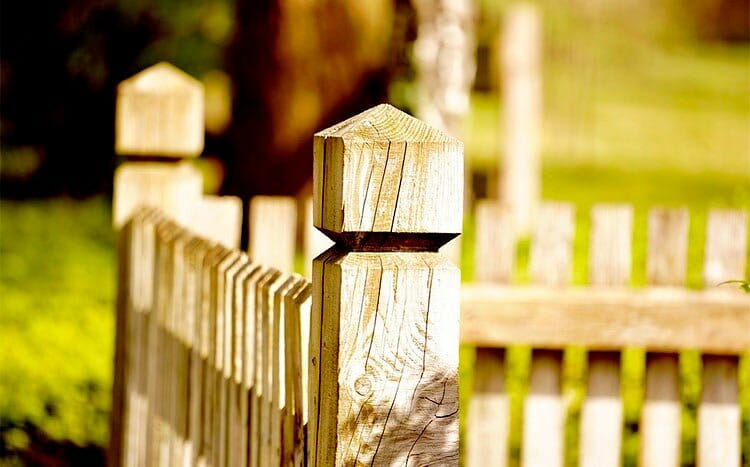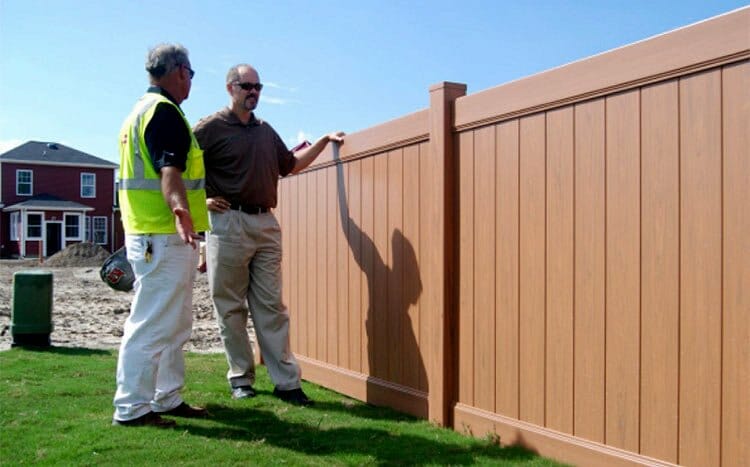In some neighborhoods, disagreements can arise around the erection of fencing, stemming from differing tastes in fence aesthetics. Furthermore, discussions can happen over how the costs of installation are split and arguments about the appropriate height for boundary fences. Even when issues like the fence’s style, its height, and the involved costs are settled, the unresolved matter of who gets the preferred side of the fence lingers.
Generally, it is good fence etiquette to swap the good side each time the fence is changed. So if you have had the good side of the fence for the last 15 – 20 years, this time around, your neighbor will get it. If you are paying for the whole fence yourself, then it goes without saying that you would get to the good side.
Here is what you should know about fence etiquette and the rules relating to boundary fences.
Which side is the good side?
Depending on the fence style, there is a front and back of the fence aka a good and bad side. Most wooden fences have a bad side and a good side.
The Good
The good side is the side with a cleaner finish and which is typically made up of vertical boards.
The Bad (… and the ugly)
The bad side is the side on which the posts and horizontal rails are visible.
Tip: For some extra money, you can add boards to your side of the fence so both sides are good. This is something that would have to be paid for separately after the fence has been erected. Your neighbor would not like to pay the extra money so you have a pretty view.

If you pay do you get the good side of the fence?
No, just because your pay does not mean that you get the good side of the fence. If you and your neighbor share the cost of the fence, then who gets the good side is a matter of negotiation. You can even choose to take turns every time you decide to change the fence whereby you swap the sides after every 10-15 years — the period after which most fences need an overhaul.
Furthermore, even in cases where you are the one who is paying for everything, it is always good neighbor etiquette to give your neighbor the good side. And since this is the norm in most places, doing otherwise will not only increase the odds of conflict with your neighbors but also make it seem like you installed the fence the wrong way.

Your rights and fence laws
In most states, the process of setting up a boundary fence is stipulated by the law. This includes rights and obligations relating to cost-sharing, fence maintenance, fence heights, and even fence removal. Here is what you should know about fence laws and the rights that you have with regard to boundary fences.
Fence laws
While laws vary from state to state, the law is typically consistent with respect to the ownership of, and the sharing of the costs of installing, a dividing fence. In most areas, the law considers such a fence to be joint property. As a result, each of the adjoining owners has an equal share with respect to rights and obligations relating to the fence. Therefore, as far as maintenance and installation costs are concerned, they are supposed to be shared between the owners of the adjoining properties.
The only exception to the equal-share rule is in cases where:
- One owner wants a fence that is more expensive than what is sufficient. In such a case, the owner who wants a fence that is of a higher standard will have to shoulder the additional costs
- In cases where the fence is damaged as a result of actions associated with one neighbor, that neighbor will have to take care of the costs of restoring and repairing it on their own
How to approach your neighbors
Good fence etiquette demands that you notify your neighbor, informally, of your intention to build a boundary fence. Have a discussion with them about your ideas for the new fence, show them any quotes you have gotten from prospective fence contractors, and then listen to his or her feedback. When doing so, be friendly, reasonable, and cheerful.
What if your neighbor objects?
After approaching the neighbor informally and getting a negative response, you can then serve them with a notice informing them of your intention to build a fence. It is a formal notice and in most cases, a lawyer can do it on your behalf.
It is important to note that this is an important step that you shouldn’t skip. This is because in most states, it is actually a provision of the law and so doing so will ensure that you are in compliance with what the law demands. The notice will specify your intention, their obligations, and may even be accompanied by quotes from contractors.
Neighbor fence disputes mediation
Even after approaching your neighbor and informing them of your intention to build the fence, they may still object. In such a case, the next logical step is to go to mediation.
With mediation, you will have neutral parties — mediators — try to help both of you to come to an amicable resolution without taking the matter to court. It is a less acrimonious method of dispute resolution, it is cheaper, and more importantly, it often leads to peaceful fence dispute resolution.
However, if mediation doesn’t work, you can then take the dispute to a magistrate’s court. While this option is typically accompanied by exorbitant lawyer fees and often leads to bad blood between neighbors, it is sometimes necessary.
FAQ's
Can my neighbor paint his side of the fence?
As far as boundary fences are concerned — which are considered jointly owned and typically involve cost-sharing among neighbors –, they can paint on their side of the fence. This is because they own part of the fence and as such have a right to also use it to their liking, provided they don’t end up damaging it.
However, if it is a fence that is built on your side of the property line, and if you built it yourself at your own expense, then they don’t have a right to paint their side of the fence. And if they do, you can sue them.
Can my neighbor hang things on the fence?
If it is a fence that you installed, and if you installed it on your side of the property line, then your neighbor can’t hang things on the fence because that is your personal property. However, if it is a boundary fence, it is jointly owned by both of you. This means that he or she owns part of the fence and as a result, they can rightfully hang things on the fence.
Who legally owns a dividing fence?
According to the law, a dividing fence is jointly owned by both neighbors. This means that they have equal rights and responsibilities as far as the fence is concerned, and this typically includes the obligation to maintain it.
Can I grow ivy on my side of the fence?
Yes, you can grow ivy on your side of the fence since you will be essentially growing it on your land — something that you have an absolute right to do.
However, if it somehow crosses the property line and invades their side of the property, they will have the right to cut the part that is overhanging. They may even be able to recover the costs of carrying out this activity.
Another thing that you should keep in mind is that ivy can damage some types of fences. Therefore, if you plant it on your side of the fence and it ends up damaging the fence, you will be solely responsible for the costs of restoring the fence.
Use this free tool to get in touch with a local fence expert
If you need help figuring out the rules and guidelines that apply when it comes to building fences in your area, getting in touch with a local expert is the best option. And the best way to do so is to use HomeGardenGuides.com. It offers a free service that quickly matches you with the top-voted local expert fence contractors.
Using the website, you can get 3 estimates fast by real certified experts in your area in just 2 minutes. Here is how it works.
- You scroll to the top of the page and enter your Zip code.
- Answer questions about your security fence needs
- Your details will be forwarded to three local experts.
- You will then receive a price estimate for the job and some friendly advice.
IMPORTANT: There is no obligation to hire. This is a free tool and service to be used at your pleasure.







